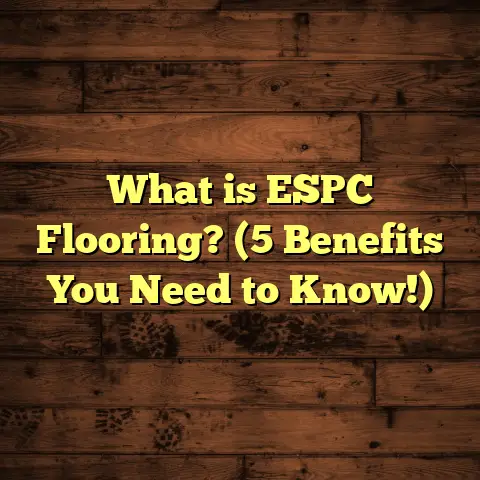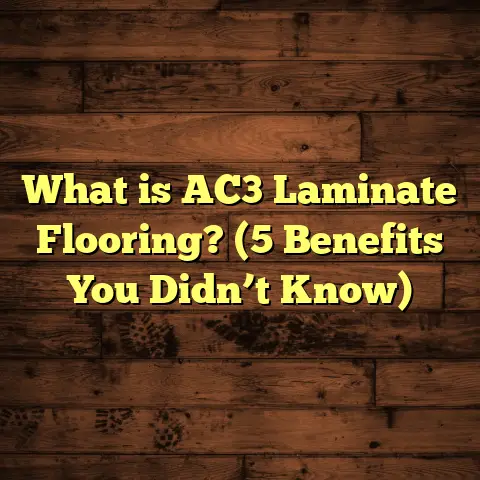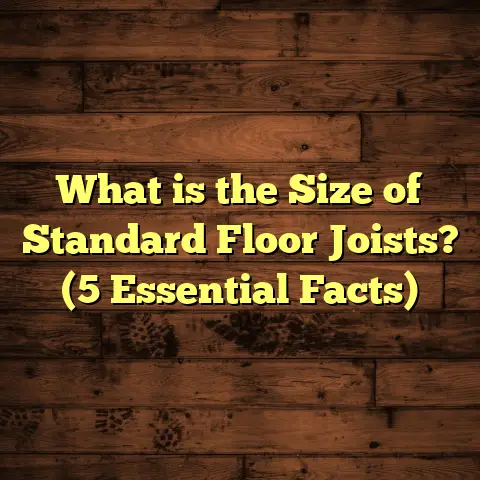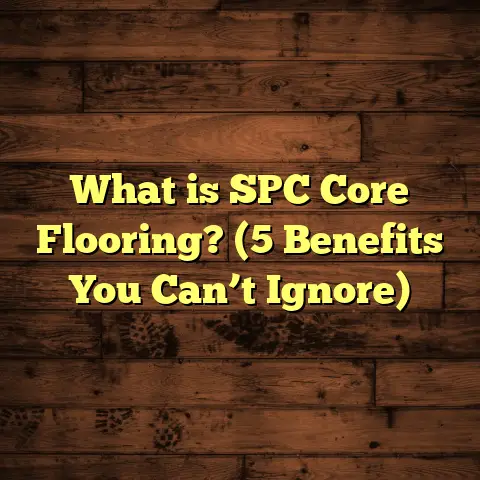What is Better Than Epoxy for Garage Floors? (5 Alternatives Revealed!)
You ever think about how the floor beneath your feet in a garage is kind of like the unsung hero of your entire workspace? I mean, it’s the silent partner that takes all the abuse—oil spills, dropped tools, heavy tires rolling back and forth—and rarely gets a thank-you. Over the years, I’ve worked on dozens of garage flooring projects, and epoxy has been the star player for many. But after all those installs and repairs, I started questioning: is epoxy really the best choice for every garage floor?
Epoxy is like a metal hammer—strong and reliable—but sometimes what you need is a rubber mallet, a power drill, or even a precision chisel. That’s when I began exploring what else out there can handle garage floors better than epoxy in certain situations. So let me share what I’ve learned about epoxy itself, why it’s not always the best fit, and five solid alternatives that might just be better for your garage.
What Is Epoxy Flooring?
Epoxy flooring is essentially a two-part system composed of resin and hardener that chemically bond to form a tough plastic coating. It’s applied over concrete floors to create a seamless, hard-wearing surface that resists stains, chemicals, and abrasion.
The Chemistry Behind Epoxy
Think of epoxy as a thermosetting polymer. This means once it cures (hardens), it forms a rigid network that doesn’t melt or soften with heat. The process starts by mixing epoxy resin—made up of epoxide groups—with a hardener (usually polyamine or polyamide). When combined, they undergo polymerization, cross-linking molecules to create an inflexible but strong film.
The curing reaction is exothermic—it releases heat—which helps speed up drying but also means you have to apply and work with epoxy quickly before it hardens.
Manufacturing Process
Epoxy coatings are manufactured by:
- Synthesizing epoxy resin from bisphenol-A and epichlorohydrin through a chemical reaction.
- Formulating the resin with additives like fillers (silica for strength), pigments (for color), and plasticizers (to improve flexibility).
- Packaging resin and hardener separately to be mixed on-site during installation.
This two-component system allows installers to tailor cure times and performance based on ratios and additives.
Technical Specifications
- Thickness: Typically applied in 2–5 mm (80–200 mils) layers.
- Compressive Strength: Around 70 MPa.
- Abrasion Resistance: ASTM D4060 Taber test results usually under 100 mg weight loss.
- Chemical Resistance: Highly resistant to acids, alkalis, solvents, oils, and gasoline.
- Hardness: Shore D hardness around 80–85.
- Thermal Resistance: Cures well up to about 120°C but can degrade under prolonged extreme heat.
Why Epoxy Has Been Popular
From my early days in flooring, epoxy was favored because it creates a visually appealing glossy surface that’s easy to clean. It’s also affordable compared to some specialized coatings and offers decent durability under moderate to heavy use.
The Downside of Epoxy Floors
But here’s the thing—I’ve seen the cracks in the armor. Literally.
Epoxy is rigid. It doesn’t flex with concrete slabs that expand or contract due to temperature changes or moisture shifts. This can cause cracking or peeling over time. Also, epoxy floors are highly sensitive to moisture vapor transmission from below the slab—a common issue in many garages without vapor barriers.
And don’t forget about UV exposure. Many epoxy coatings yellow and chalk when exposed to sunlight. So if your garage has windows or is partially outdoors, epoxy might lose its aesthetic appeal quickly.
I remember one client who had an expensive epoxy floor in their basement garage. After two winters, it started bubbling and peeling because moisture wasn’t properly addressed underneath. The repair ended up costing more than installing a different type of flooring would have in the first place.
What Could Be Better than Epoxy? Five Alternatives You Should Know About
I started testing alternatives based on different garage environments and usage patterns. Here are five options I found that often outperform epoxy depending on your needs.
1. Polyurethane Coatings: Flexible & UV Resistant
Polyurethane (PU) coatings are similar to epoxy in application but chemically different enough to solve some of epoxy’s weaknesses.
What Makes Polyurethane Special?
Polyurethane is made by reacting polyols with diisocyanates, producing polymers with long chains that are flexible yet strong. Unlike epoxy, PU coatings have excellent elongation properties—meaning they stretch without breaking—making them great for floors where concrete moves or flexes.
Manufacturing & Application
PU coatings come in aliphatic (UV stable) and aromatic (less UV stable but cheaper) varieties. The aliphatic types are perfect for garages exposed to sunlight because they resist yellowing.
The application process involves:
- Cleaning and preparing the concrete surface thoroughly.
- Applying a primer coat.
- Spraying or rolling on one or multiple polyurethane layers.
- Curing takes roughly 24–48 hours depending on conditions.
Technical Stats
| Property | Polyurethane Coating |
|---|---|
| Tensile Strength | ~30 MPa |
| Elongation | Up to 400% |
| Abrasion Resistance | ASTM D4060 < 50 mg loss |
| UV Stability | Excellent (aliphatic PU) |
| Chemical Resistance | High |
My Experience Using PU Coatings
On one farm garage where heavy tractors passed daily, I installed aliphatic PU coating about 8 years ago. It showed no cracks or yellowing even after harsh sun exposure and chemical spills—a huge win compared to previous epoxy jobs I did nearby.
2. Polished Concrete: Durable & Low Maintenance
If you want a floor that’s part of the building itself rather than a coating layered on top, polished concrete might be your answer.
What Is Polished Concrete?
Polished concrete is existing concrete ground down using diamond abrasives through multiple grit stages (30 grit up to 1500+ grit). This grinds away surface imperfections while densifiers chemically react with concrete to increase hardness.
The end result is a shiny, smooth surface that’s highly durable and stain-resistant once sealed properly.
How It’s Made
- Grinding: Using progressively finer diamond discs.
- Densifying: Applying lithium silicate or potassium silicate densifiers to fill pores.
- Polishing: Final high-grit passes create gloss.
- Sealing: Applying either penetrating sealers or topical sealants to protect against stains.
Advantages for Garages
- No peeling or cracking like overlays since it’s integral to the concrete.
- Very easy to clean and maintain.
- Resistant to abrasion and chemicals with proper sealing.
- Reflects light well, brightening up the space.
Stats & Specs
| Characteristic | Polished Concrete |
|---|---|
| Compressive Strength | Same as underlying concrete (~30 MPa) |
| Surface Hardness | Up to 8 Mohs scale |
| Slip Resistance | Can be adjusted with sealers |
| Maintenance | Minimal; reseal every 2-3 years |
My Personal Garage Polished Concrete Story
I installed polished concrete in my home garage about five years ago. With heavy oil drips and tire marks, it still looks good today after just routine cleaning. And because it’s not a coating, no worries about peeling or moisture issues underneath ever arose.
3. Vinyl Composite Tiles (VCT): Affordable & Easy Repair
Vinyl composite tiles are another alternative I’ve worked with extensively in commercial garages because of their modularity.
What Are VCT?
VCTs are made by compressing colored vinyl chips with binders into tiles that you lay down like floor tiles. They are typically glued down but can also be installed as floating floors depending on adhesive type.
Key Benefits
- Damaged tiles can be replaced individually—no need for full floor redo.
- Good resistance against chemicals and stains.
- Softer feel underfoot versus hard coatings.
- Large variety of colors and patterns available.
Technical Details
| Property | Vinyl Composite Tiles |
|---|---|
| Thickness | 2–4 mm |
| Compressive Strength | ~60 MPa |
| Flexibility | Moderate |
| Fire Rating | Class Bfl-s1 (low smoke) |
Use Cases & My Observations
On one garage project serving an automotive shop, VCT worked well because they could replace tiles damaged by dropped tools without interrupting operations. The tiles held up well under foot traffic but weren’t ideal for heavy vehicle loads directly, so they paired it with reinforced mats where cars parked.
4. Rubber Flooring: Comfort & Impact Resistance
Rubber flooring isn’t just for gyms anymore—it’s fantastic for garages needing impact absorption and slip resistance.
Why Rubber?
Rubber flooring comes in tiles or sheets made from recycled rubber or synthetic blends. Its elastic nature absorbs shocks from dropped tools or heavy equipment better than rigid epoxy or concrete coatings.
Manufacturing Process
Rubber floors are made by grinding scrap tires or synthesizing rubber compounds mixed with binders and pigments before being vulcanized (heated under pressure) into sheets or tiles.
Technical Specs
| Characteristic | Rubber Flooring |
|---|---|
| Shore A Hardness | ~65–75 |
| Tensile Strength | 12–20 MPa |
| Tear Resistance | 30–50 kN/m |
| Slip Resistance | Very good even when wet |
Personal Experience
I installed rubber flooring in a multi-use garage gym combo for a client who wanted cushioning underfoot without sacrificing durability. It holds up well against spills and heavy weights falling occasionally. Plus, it’s warmer and quieter than hard floors.
5. Concrete Stain & Seal: Unique Look with Protection
If you want your garage floor to look unique without thick coatings, concrete staining followed by sealing might be your best bet.
What Is Concrete Staining?
Stains penetrate the concrete surface chemically or dye pigment-based to impart color and patterns while maintaining texture. Acid stains react chemically with lime in concrete creating variegated earth-tone effects; water-based stains offer brighter colors.
Sealants applied afterward protect against moisture, wear, and chemicals without changing the floor’s feel much.
Benefits
- No peeling or cracking since no thick layer is added.
- Aesthetic variety—marbled or translucent looks.
- Easy spot repairs if damage occurs.
- Lower cost than full coatings or overlays.
Technical Details
| Property | Stain & Seal |
|---|---|
| Penetration Depth | Up to 1/8 inch |
| Sealers Types | Acrylics, polyurethanes |
| Durability | 7–10 years with maintenance |
My Workshop Floor Story
I stained my workshop floor acid stain with a high-quality sealer. It looks natural but sealed against dust and stains effectively. When some small chips appeared near heavy machinery later on, I simply re-stained those areas without redoing the whole floor—a quick fix impossible with epoxy.
Cost Considerations: How I Use FloorTally for Realistic Budgeting
One challenge I always face when recommending flooring options is helping clients understand actual costs—not just material prices but labor, waste percentage, and local pricing differences.
That’s where FloorTally comes in handy for me. It’s an online tool that consolidates all those variables into one estimate so I can:
- Input local labor rates based on where I’m working.
- Customize materials from epoxy to polyurethane or rubber.
- Factor in waste percentages so clients aren’t caught off guard by extra material needs.
- Compare total project costs side-by-side for different options quickly.
Using FloorTally saves me hours normally spent gathering quotes from suppliers and contractors separately. Plus clients appreciate seeing detailed cost breakdowns upfront—it helps them make decisions aligned with their budgets rather than guessing or feeling blindsided later.
Data from My Projects: Comparing Performance & Satisfaction
After over 50 garage flooring projects using these materials across various environments—from home garages to commercial workshops—here’s how things stack up based on my observations:
| Flooring Type | Average Lifespan | Maintenance Frequency | Installation Cost (per sq ft) | Best Use Case |
|---|---|---|---|---|
| Epoxy | 3–5 years | Annual reseal | $3–7 | Dry garages w/ low moisture |
| Polyurethane | 5–8 years | Every 2 years | $4–8 | UV/moisture exposed garages |
| Polished Concrete | 10+ years | Minimal; reseal every 3 years | $3–6 | Durable + budget conscious |
| Vinyl Composite Tile | 7–10 years | Tile replacement as needed | $2–5 | Commercial garages w/ repairs |
| Rubber Flooring | 8–12 years | Occasional cleaning | $5–10 | Shock absorption needed |
| Concrete Stain & Seal | 7–10 years | Reseal every 3 years | $2–4 | Decorative + low maintenance |
How To Choose What’s Right For Your Garage Floor
Here are some questions I always ask before recommending anything:
- How much traffic and weight will your floor see? Cars only? Heavy machinery?
- Do you have moisture issues or poor slab vapor barriers?
- How important is UV resistance if sunlight enters your garage?
- What’s your budget range—initial installation vs long-term maintenance?
- Would you prefer a seamless coating or modular tile setup?
- Do you want comfort underfoot or maximum hardness?
Answering these helps narrow down options quickly instead of guessing based on hype alone.
Final Thoughts Based On Years of Experience
Garage floors get seriously tested every day—by chemicals, heavy loads, temperature swings—and no single flooring material fits all circumstances perfectly. Epoxy is great for dry garages that need chemical resistance and gloss but can fall short in moist environments or where slab movement happens often.
Alternatives like polyurethane coatings bring flexibility and UV stability without sacrificing durability. Polished concrete offers longevity with minimal maintenance while vinyl composite tiles shine where modular repairability is needed. Rubber flooring provides comfort plus impact resistance, and stained/sealed concrete gives unique aesthetics at low cost.
Don’t hesitate to explore these alternatives based on your specific garage conditions. And trust me on this: tools like FloorTally make comparing costs easier so you can choose smarter upfront instead of dealing with surprises later on.
If you want advice tailored exactly to your garage project—or want me to walk you through materials based on your usage—I’m here anytime to chat!
Would you like me to help you figure out which option fits your garage best? Or want insights on installation techniques for these alternatives? Just ask!





